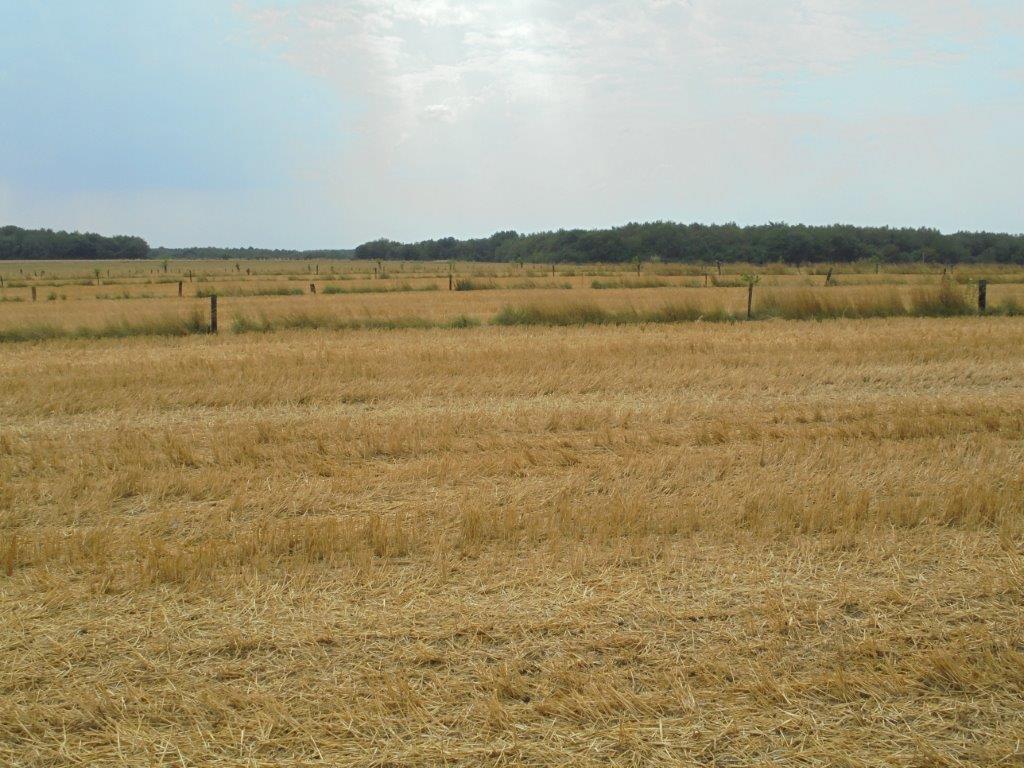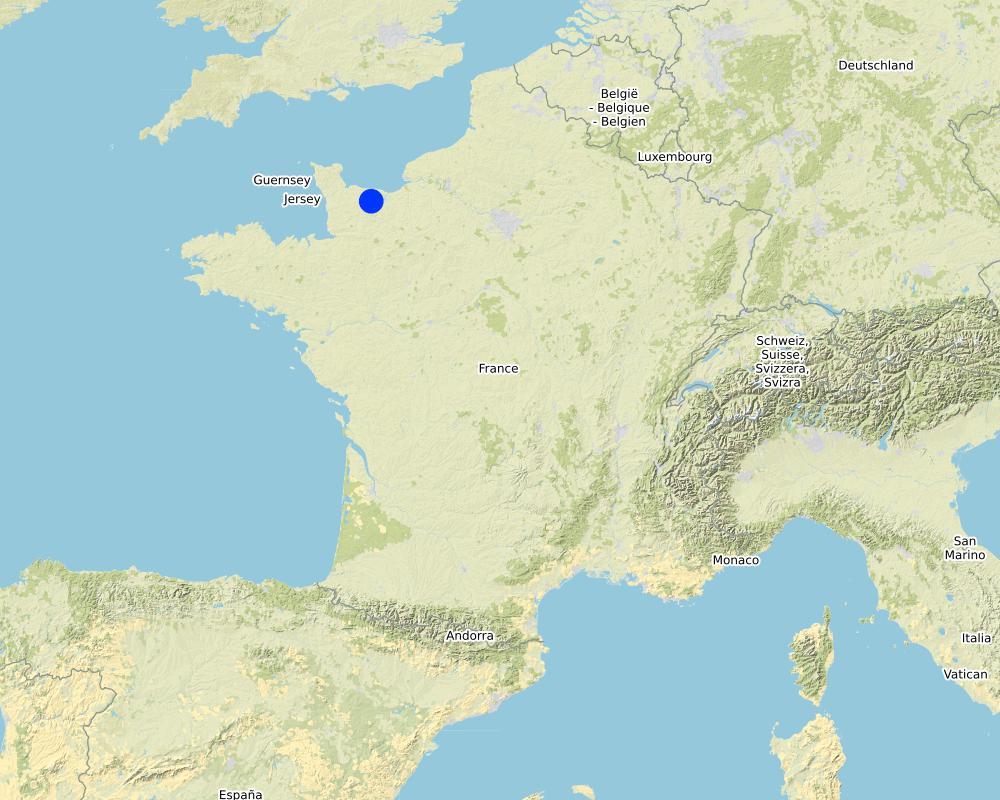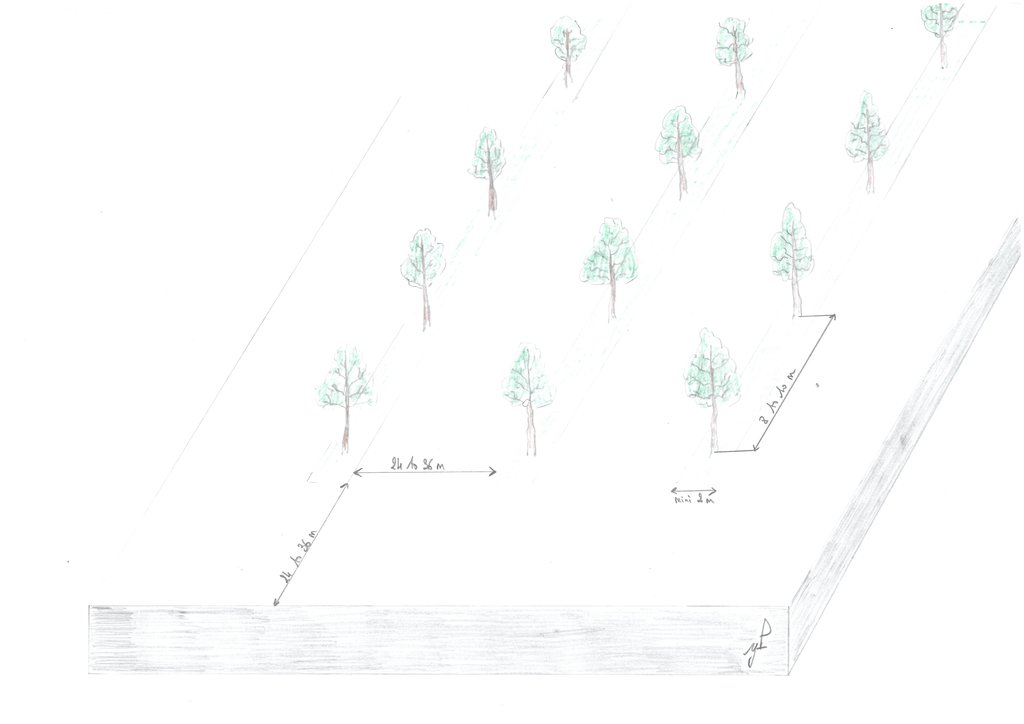Alley cropping - Agroforestry [法国]
- 创建:
- 更新:
- 编制者: Alan Radbourne
- 编辑者: David Norris, Sabine Reinsch
- 审查者: Rima Mekdaschi Studer, William Critchley
agroforesterie intra parcellaire
technologies_5645 - 法国
查看章节
全部展开 全部收起1. 一般信息
1.2 参与该技术评估和文件编制的资源人员和机构的联系方式
关键资源人
SLM专业人员:
Pivain Yann
Chambre d’agriculture de Normandie
法国
SLM专业人员:
Galmel Michel
Ferme des Ruelles
法国
有助于对技术进行记录/评估的项目名称(如相关)
European Interreg project FABulous Farmers有助于对技术进行记录/评估的机构名称(如相关)
UK Centre for Ecology & Hydrology (CEH) - 英国有助于对技术进行记录/评估的机构名称(如相关)
Association des Chambres d’agriculture de l’Arc Atlantique (AC3A) - 法国1.3 关于使用通过WOCAT记录的数据的条件
编制者和关键资源人员接受有关使用通过WOCAT记录数据的条件。:
是
1.4 所述技术的可持续性声明
这里所描述的技术在土地退化方面是否存在问题,导致无法被认为是一种可持续的土地管理技术?:
否
2. SLM技术的说明
2.1 技术简介
技术定义:
The implementation of agroforestry in a cereal field can help aid biodiversity, that will in turn support natural pest control, improve the resilience to water and climate stress through improved infiltration, provide more shade and less wind-stress, and will improve soil health, among other benefits.
2.2 技术的详细说明
说明:
Agroforestry, that is the incorporation of trees into agriculture, is a traditional land management practice in Normandy using apple trees inter-grazed by cows on pasture. However, between 1960 and 2000, the restructuring of agricultural land, and technical and technological developments, have led to the disappearance of agroforestry in Normandy. Since the beginning of the 21 century, the integration of trees into the system has started to be reintroduced, not only in grassland systems, but also in crop fields.
The integration of trees into the system is effective for countering:
- Biological degradation: by enhancing biodiversity though improved refuge for insects and birds, providing food for them, breeding opportunities and connectivity corridors across the landscape. This leads to greater biological regulation of crop pests among other benefits.
- Climate related stress: both at the local level (decrease of wind speeds, reduction of evapotranspiration, shade for animals) and at the global level (carbon storage, substitution of fossil energies by renewable energy).
- Water degradation: through the qualitative and quantitative regulation of water at the watershed scale as a benefit of improved rainfall infiltration and less fertilizer lost in runoff.
- Soil erosion by water and chemical deterioration: through the conservation of soils with reduced runoff.
- Soil erosion by wind: through the protection of exposed areas.
and:
- Providing benefits through beautification of the living environment.
As part of the agroforestry SLM technology, trees are planted on grassed strips which are 24 to 30 m apart within the field of cereals. Trees are spaced 8 to 10 m within the strips. This configuration has been adapted to allow mechanized agriculture. The main tree species used are Quercus, Sorbus, Tilia, Prunus and Robinia. Land users, with some support from the local community, financed the re-introduction of agroforestry into Normandy. Soil was prepared using machinery (single line ploughing), mulch was applied and tree seedlings were protected against wild animals.
Despite these financial and management benefits. the SLM technology has not yet been taken up widely. Therefore, the aim is to promote better adoption of agroforestry practices by Normandy farmers. This is becoming more important as the use of external inputs (e.g. fertilizers and pesticides) is increasingly expensive for both farmers and society - and the introduction of agroforestry can both help reduce these costs with more natural pest control and less runoff of fertilisers from the fields.
The compilation of this SLM is a part of the European Interreg project FABulous Farmers which aims to reduce the reliance on external inputs by encouraging the use of methods and interventions that increase the farm’s Functional AgroBiodiversity (FAB). Visit www.fabulousfarmers.eu and www.nweurope.eu/Fabulous-Farmers for more information.
2.3 技术照片
2.5 已应用该技术的、本评估所涵盖的国家/地区/地点
国家:
法国
区域/州/省:
Normandy
具体说明该技术的分布:
- 适用于特定场所/集中在较小区域
技术现场是否位于永久保护区?:
否
注释:
(note map represents region of Normandy not precise location of technology due to protection of GDPR location data)
Map
×2.6 实施日期
注明实施年份:
2017
如果不知道确切的年份,请说明大概的日期:
- 不到10年前(最近)
2.7 技术介绍
详细说明该技术是如何引入的:
- 通过土地使用者的创新
- 通过项目/外部干预
注释(项目类型等):
Farmer innovation and interest has been linked to projects encouraging the uptake of functional agrobiodiversity measures; the project in this case is the EU Interreg Fabulous Farmers project.
3. SLM技术的分类
3.1 该技术的主要目的
- 改良生产
- 减少、预防、恢复土地退化
- 保持/提高生物多样性
- 适应气候变化/极端天气及其影响
- 创造有益的经济影响
3.2 应用该技术的当前土地利用类型
同一土地单元内混合使用的土地::
是
具体说明混合土地使用(作物/放牧/树木):
- 农林业

农田
- 一年一作
年作 - 具体指明作物:
- 谷类 - 大麦
- 谷物类 - 玉米
- Several species over the years, varies by farm
每年的生长季节数:
- 1
采用间作制度了吗?:
否
采用轮作制度了吗?:
是
如果是,请具体说明:
Primarily rotation of cereal crops on an annual basis.
3.3 由于技术的实施,土地使用是否发生了变化?
由于技术的实施,土地使用是否发生了变化?:
- 否(继续问题3.4)
同一土地单元内混合使用的土地::
是
具体说明混合土地使用(作物/放牧/树木):
- 农林业
3.4 供水
该技术所应用土地的供水:
- 雨养
3.5 该技术所属的SLM组
- 农业林学
- 防风林/防护林带
- 病虫害综合管理(包括有机农业)
3.6 包含该技术的可持续土地管理措施

农艺措施
- A2:有机质/土壤肥力

植物措施
- V1:乔木和灌木覆盖层

管理措施
- M1:改变土地使用类型
3.7 该技术强调的主要土地退化类型

土壤水蚀
- Wt:表土流失/地表侵蚀
- Wg:冲沟侵蚀/沟蚀

土壤风蚀
- Et:表土流失

化学性土壤退化
- Cn:肥力下降和有机质含量下降(非侵蚀所致)

生物性退化
- Bh:栖息地丧失
- Bs:质量和物种组成/多样性的下降
- Bp:害虫/疾病增加,捕食者减少
3.8 防止、减少或恢复土地退化
具体数量名该技术与土地退化有关的目标:
- 防止土地退化
- 减少土地退化
4. 技术规范、实施活动、投入和成本
4.1 该技术的技术图纸
技术规范(与技术图纸相关):
The agroforestry trees are planted on grassed strips of at least 2 m width, 24 to 36 m apart, in a 17 ha field of cereals.
The trees are spaced 8 to 10 m apart.
The configuration is adapted to mechanised agriculture.
The main species used: Quercus, Sorbus, Tilia, Prunus and Robinia. Any dead trees are replaced in the first 3 years.
作者:
Yann Pivain
日期:
01/11/2019
4.2 有关投入和成本计算的一般信息
具体说明成本和投入是如何计算的:
- 每个技术区域
注明尺寸和面积单位:
1 ha
如果使用本地面积单位,注明转换系数为1公顷(例如1公顷=2.47英亩):1公顷=:
1ha = 2.47 acres
其它/国家货币(具体说明):
€
如相关,注明美元与当地货币的汇率(例如1美元=79.9巴西雷亚尔):1美元=:
0.9
注明雇用劳工的每日平均工资成本:
120
4.3 技术建立活动
| 活动 | 时间(季度) | |
|---|---|---|
| 1. | Choice of the planting site, the design/layout and the species | Spring |
| 2. | Soil preparation (clearing of land, harrowing) | After harvest of crops |
| 3. | Application of mulch to planting strips | After harvest of crops |
| 4. | Tree whips planted in plough slot (approx. 10cm deep), protection spirals fitted and area recovered with mulch | From Nov to Jan |
4.4 技术建立所需要的费用和投入
| 对投入进行具体说明 | 单位 | 数量 | 单位成本 | 每项投入的总成本 | 土地使用者承担的成本% | |
|---|---|---|---|---|---|---|
| 劳动力 | Design & layout of planting | days | 0.5 | 120.0 | 60.0 | 100.0 |
| 劳动力 | Surface preparation (clearing & harowing) | days | 0.1 | 120.0 | 12.0 | 100.0 |
| 劳动力 | Mulch application | days | 0.2 | 120.0 | 24.0 | 100.0 |
| 劳动力 | Planting | days | 0.5 | 120.0 | 60.0 | 100.0 |
| 设备 | Tractor with harow & Plough | days | 0.3 | 50.0 | 15.0 | 100.0 |
| 植物材料 | Tree whips | piece/ha | 30.0 | 3.0 | 90.0 | 20.0 |
| 植物材料 | Mulch | piece/ha | 30.0 | 2.0 | 60.0 | 20.0 |
| 施工材料 | Base spiral protection | piece/ha | 30.0 | 2.0 | 60.0 | 20.0 |
| 技术建立所需总成本 | 381.0 | |||||
| 技术建立总成本,美元 | 423.33 | |||||
如果土地使用者负担的费用少于100%,请注明由谁负担其余费用:
Local community and grant funding
4.5 维护/经常性活动
| 活动 | 时间/频率 | |
|---|---|---|
| 1. | Tree maintenance (pruning by hand as required) | from Jun to Dec all year around |
| 2. | Grass strip mowing (using tractor) | after crop harvest |
4.6 维护/经常性活动所需要的费用和投入(每年)
| 对投入进行具体说明 | 单位 | 数量 | 单位成本 | 每项投入的总成本 | 土地使用者承担的成本% | |
|---|---|---|---|---|---|---|
| 劳动力 | Tree pruning | days | 2.0 | 120.0 | 240.0 | 100.0 |
| 劳动力 | Grass mowing | days | 1.0 | 120.0 | 120.0 | 100.0 |
| 设备 | Tractor & mower | days | 1.0 | 50.0 | 50.0 | 100.0 |
| 技术维护所需总成本 | 410.0 | |||||
| 技术维护总成本,美元 | 455.56 | |||||
4.7 影响成本的最重要因素
描述影响成本的最决定性因素:
Time necessary for maintenance.
Good training to do quality work.
5. 自然和人文环境
5.1 气候
年降雨量
- < 250毫米
- 251-500毫米
- 501-750毫米
- 751-1,000毫米
- 1,001-1,500毫米
- 1,501-2,000毫米
- 2,001-3,000毫米
- 3,001-4,000毫米
- > 4,000毫米
指定年平均降雨量(若已知),单位为mm:
650.00
有关降雨的规范/注释:
No dry season or marked rainy season. Rain falls fairly regularily.
注明所考虑的参考气象站名称:
Les Andelys
农业气候带
- 半湿润
5.2 地形
平均坡度:
- 水平(0-2%)
- 缓降(3-5%)
- 平缓(6-10%)
- 滚坡(11-15%)
- 崎岖(16-30%)
- 陡峭(31-60%)
- 非常陡峭(>60%)
地形:
- 高原/平原
- 山脊
- 山坡
- 山地斜坡
- 麓坡
- 谷底
垂直分布带:
- 0-100 m a.s.l.
- 101-500 m a.s.l.
- 501-1,000 m a.s.l.
- 1,001-1,500 m a.s.l.
- 1,501-2,000 m a.s.l.
- 2,001-2,500 m a.s.l.
- 2,501-3,000 m a.s.l.
- 3,001-4,000 m a.s.l.
- > 4,000 m a.s.l.
说明该技术是否专门应用于:
- 不相关
5.3 土壤
平均土层深度:
- 非常浅(0-20厘米)
- 浅(21-50厘米)
- 中等深度(51-80厘米)
- 深(81-120厘米)
- 非常深(> 120厘米)
土壤质地(表土):
- 中粒(壤土、粉土)
- 细粒/重质(粘土)
土壤质地(地表以下> 20厘米):
- 细粒/重质(粘土)
表土有机质:
- 中(1-3%)
5.4 水资源可用性和质量
地下水位表:
> 50米
地表水的可用性:
好
水质(未处理):
不良饮用水(需要处理)
水质请参考::
地下水和地表水
水的盐度有问题吗?:
否
该区域正在发生洪水吗?:
是
规律性:
偶然
5.5 生物多样性
物种多样性:
- 中等
栖息地多样性:
- 高
关于生物多样性的注释和进一步规范:
Technology has supported the continued high biodiversity in the region, limiting any possible decline with changing farming practice.
5.6 应用该技术的土地使用者的特征
定栖或游牧:
- 定栖的
生产系统的市场定位:
- 商业/市场
非农收入:
- 收入的10-50%
相对财富水平:
- 丰富
个人或集体:
- 个人/家庭
机械化水平:
- 机械化/电动
性别:
- 男人
土地使用者的年龄:
- 中年人
5.7 应用该技术的土地使用者使用的平均土地面积
- < 0.5 公顷
- 0.5-1 公顷
- 1-2 公顷
- 2-5公顷
- 5-15公顷
- 15-50公顷
- 50-100公顷
- 100-500公顷
- 500-1,000公顷
- 1,000-10,000公顷
- > 10,000公顷
这被认为是小规模、中规模还是大规模的(参照当地实际情况)?:
- 小规模的
5.8 土地所有权、土地使用权和水使用权
土地所有权:
- 个人,未命名
土地使用权:
- 个人
用水权:
- 社区(有组织)
土地使用权是否基于传统的法律制度?:
否
5.9 进入服务和基础设施的通道
健康:
- 贫瘠
- 适度的
- 好
教育:
- 贫瘠
- 适度的
- 好
技术援助:
- 贫瘠
- 适度的
- 好
就业(例如非农):
- 贫瘠
- 适度的
- 好
市场:
- 贫瘠
- 适度的
- 好
能源:
- 贫瘠
- 适度的
- 好
道路和交通:
- 贫瘠
- 适度的
- 好
饮用水和卫生设施:
- 贫瘠
- 适度的
- 好
金融服务:
- 贫瘠
- 适度的
- 好
6. 影响和结论性说明
6.1 该技术的现场影响
社会经济效应
生产
作物生产
注释/具体说明:
Less land available for cropping
作物质量
注释/具体说明:
No change seen
木材生产
注释/具体说明:
Wood produce now integrated
产品多样性
注释/具体说明:
Wood product added
土地管理
注释/具体说明:
Tree lines set for as much ease of mechanical use as possible, yet still does disrupt ease of crop management
收入和成本
农业收入
注释/具体说明:
Loss of crop area, yet some less inputs required (i.e. pesticide)
收入来源的多样性
注释/具体说明:
Wood and cereal crop combined
工作量
注释/具体说明:
Tree maintenence takes longer than when working a single crop field
社会文化影响
SLM/土地退化知识
注释/具体说明:
Improved skill set with learning & training in agroforestry
生态影响
水循环/径流
水质
注释/具体说明:
Trees act as buffer strips for better quality water with less run-off
地表径流
注释/具体说明:
Trees act as buffer strips for better quality water with less run-off
多余水的排放
注释/具体说明:
Improved soil infiltration
土壤
土壤水分
注释/具体说明:
Improved soil infiltration and moisture capacity
土壤流失
注释/具体说明:
Trees act as buffer strips for better quality soil with less run-off erosion
土壤堆积
注释/具体说明:
Trees act as buffer strips for better quality soil with less run-off erosion for bette accumlation
土壤压实
注释/具体说明:
Stips of trees require less passes of tractor in field
养分循环/补给
注释/具体说明:
Trees can use deeper nutrient stores
土壤有机物/地下C
注释/具体说明:
Increased carbon below ground with larger tree rooting systems
生物多样性:植被、动物
植被覆盖
注释/具体说明:
Diversity of vegetation between tree grass strips
生物量/地上C
注释/具体说明:
Trees hold more above ground C
植物多样性
注释/具体说明:
With trees and diversity of vegetation between tree grass strips
有益物种
注释/具体说明:
Natural pest control through habitat for predators with trees
栖息地多样性
注释/具体说明:
More space for habitat
害虫/疾病控制
注释/具体说明:
Natural pest control through habitat for predators with trees
减少气候和灾害风险
洪水影响
注释/具体说明:
Increased infiltration reduces flood impacts
干旱影响
注释/具体说明:
Improvements in soil moisture capacity
风速
注释/具体说明:
Trees act as shelter belts for crops
6.2 该技术的场外影响已经显现
地下水/河流污染
注释/具体说明:
Less and cleaner water run off due to buffer strips
风力搬运沉积物
注释/具体说明:
Shelter belt reduces wind erosion
对邻近农田的破坏
注释/具体说明:
Shelter belt effect felt in neighbouring fields
对公共/私人基础设施的破坏
6.3 技术对渐变气候以及与气候相关的极端情况/灾害的暴露和敏感性(土地使用者认为的极端情况/灾害)
渐变气候
渐变气候
| 季节 | 增加或减少 | 该技术是如何应对的? | |
|---|---|---|---|
| 年温度 | 增加 | 好 |
气候有关的极端情况(灾害)
气象灾害
| 该技术是如何应对的? | |
|---|---|
| 局地风暴 | 好 |
气候灾害
| 该技术是如何应对的? | |
|---|---|
| 热浪 | 适度 |
| 干旱 | 适度 |
水文灾害
| 该技术是如何应对的? | |
|---|---|
| 比较和缓的(河道)洪水 | 不好 |
| 山洪暴发 | 不好 |
| 风暴潮/沿海洪水 | 不好 |
| 滑坡 | 不好 |
生物灾害
| 该技术是如何应对的? | |
|---|---|
| 流行病 | 适度 |
| 昆虫/蠕虫侵扰 | 适度 |
其他气候相关的后果
其他气候相关的后果
| 该技术是如何应对的? | |
|---|---|
| 延长生长期 | 不好 |
| 缩短生长期 | 非常不好 |
| 海平面上升 | 非常不好 |
6.4 成本效益分析
技术收益与技术建立成本相比如何(从土地使用者的角度看)?
短期回报:
消极
长期回报:
稍微积极
技术收益与技术维护成本/经常性成本相比如何(从土地使用者的角度看)?
短期回报:
轻度消极
长期回报:
中性/平衡
6.5 技术采用
- 单例/实验
在所有采用这项技术的人当中,有多少人是自发的,即未获得任何物质奖励/付款?:
- 0-10%
6.6 适应
最近是否对该技术进行了修改以适应不断变化的条件?:
否
6.7 该技术的优点/长处/机会
| 土地使用者眼中的长处/优势/机会 |
|---|
| Reduced wind speeds and wind erosion. |
| Creation of reception areas for biodiversity. |
| 编制者或其他关键资源人员认为的长处/优势/机会 |
|---|
| Creation of climate zone "temperate" favorable to crops and / or animals. |
| Biodiversity increase leading to functional benefits of agricultural production. |
| Mixed landscape provides a positive social experience |
| Creation of training and and workshops to share implementation and production of artwork wood and / or energy wood. |
6.8 技术的弱点/缺点/风险及其克服方法
| 土地使用者认为的弱点/缺点/风险 | 如何克服它们? |
|---|---|
| Cost and maintenance time | Engage interested local community to support |
| Possible financial instability of the subsidy payments with regards to hedges | unknown |
| 编制者或其他关键资源人员认为的弱点/缺点/风险 | 如何克服它们? |
|---|---|
| Possible financial instability of the subsidy payments with regards to hedges | Unknown |
7. 参考和链接
7.1 信息的方法/来源
- 实地考察、实地调查
One farmer and compiler supporting planning and implementation
- 与土地使用者的访谈
- 根据报告和其他现有文档进行编译
Agroforesterie, des arbres et des cultures, Fabien Liagre / Christian Dupraz, éditions France Agricole, 2008 (ISBN 978-2-85557-150-8)
(现场)数据是什么时候汇编的?:
08/10/2019
7.2 参考可用出版物
标题、作者、年份、ISBN:
Agroforesterie, des arbres et des cultures, Fabien Liagre / Christian Dupraz, éditions France Agricole, 2008 (ISBN 978-2-85557-150-8)
可以从哪里获得?成本如何?
Online / 45 €
链接和模块
全部展开 全部收起链接
无链接
模块
无模块





